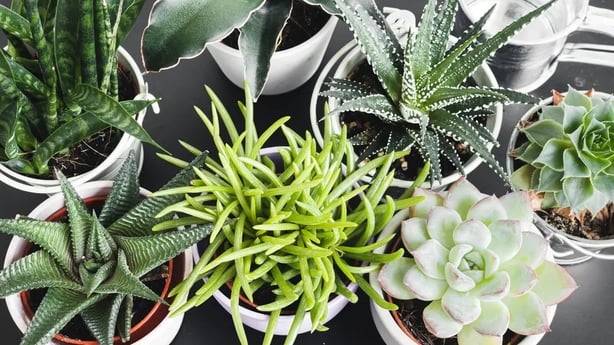If you want inspiration for displaying drought-tolerant houseplants in your home, Emma Allen of RHS Garden Wisley manager has some suggestions...
Epiphytic cacti
"These normally grow on trees or other living organisms, so don’t require soil," she explains. The smaller rhipsalis are readily available from garden centres and nurseries.
"They don’t need much watering and you can keep them in a hanging basket in fairly decent light levels," she suggests. "We like the ones which have a purple tint to them. Their leaves are almost like a Christmas cactus."
Bromeliads
"Bromeliads are colourful houseplants which are also epiphytes, so they grow on trees (in the wild) and don’t need water and soil in the same way (as other houseplants), and again they need good light levels."
Euphorbia
"Quite often euphorbia look like cacti but they are not. They are from a completely different family. Euphorbia are from Africa, while cacti are from America. Euphorbia Trigona f. rubra (the African milk tree), has a lovely purple colour. I don’t water it often and they grow quite quickly."

Pachypodium
Also known as the Madagascar palm, these unusual-looking shrubby succulents have leaves growing around the swollen trunk.
You can place them in small pots, although they do eventually grow very tall, but they need little watering and the bigger, more mature specimens produce beautiful white flowers.
Flowering plants
"Agaves look the same as aloes but are very different plants and often get confused until they flower," Allen explains.
"All aloes repeat flower, while agaves only flower once in their lifetime and then they die, sending out vegetative pups at the base, or they reseed.
"Aloes will flower as houseplants in late winter, in a mix of colours, depending on the species. They are not tropical plants, so your house temperature should be fine."
Echeveria will regularly flower in shades of pink, red, orange, yellow and white. The flower stalks emerge from the centre of the plant and you can put them outside in summer, where they should continue to flower, she says.
Cacti can be difficult to flower
"Some cacti are difficult to get to flower, because getting high-enough light levels can be hard," says Allen.
"You need to put them in as much sun as possible. So I’d go down the euphorbia and succulent route to start. But crassula should flower for you if the light levels are high enough."
Snake plants
Sansevieria (snake plants) are also a good plant if you are a neglectful owner, she suggests, as they require very little water, will tolerate bright direct light to moderate shade and will bounce back if you don’t water them for weeks.

Cycas revoluta (Japanese sago palm)
These make unusual houseplants with their dramatic, architectural green foliage, arching, pinnate-shaped fronds with sharp tips spreading out around a central cone.
Native to southern Japan and China, they are not actually palms but cycads, evergreen perennials with dark, woody trunks. The species dates back millions of years to prehistoric times.
If you want a tall plant, buy it big because they are slow-growing. They should thrive in free-draining soil or compost in full sun and you can put them outside in the summer. "You can pretty much grow these outside in London and milder parts of the UK," says Allen.
Shade tolerant
Those which need less light include ferns, which also don’t need a lot of water, she advises. Phlebodium ‘Blue Star’, for instance, can soften a dark corner. Shade-tolerant succulents include gasteria and haworthia, while a few aloe and agave can get sunburnt, so can tolerate some shade.

